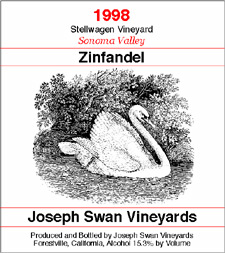 |
|
Wine Details
Price:
$22.00 per bottle
Description:
Although all of our zinfandel vineyards produce different expressions of the varietal, the Stellwagen, coming as it does from the slightly warmer Sonoma Valley, is the most unusual. Over the years we have developed quite a following for this vineyard that produces the “pinot noir” of zinfandels. Usual descriptors run to deep red fruit and white pepper in contrast to the Russian River Valley’s more black berry/black pepper. The 1998 while having the Stellwagen “signature”, shows more dark character and structure than usual. A recent review by Robert Parker referred to, among other things, “kinky, leather notes”! I have never smelled kinky leather, but to be fair he reviewed the wines after only about 3 weeks in bottle. Dan Berger in his Vintage Wine Experience said, “Exceptional. Fairly concentrated aroma of blackberry and spices like basil and thyme, with hints of black pepper and raspberry in the aftertaste. A weighty wine with more than 14% alcohol, but perfectly structured”. It sounds like one heck of a wine—and it is! 356 cases bottled.
|
|
|